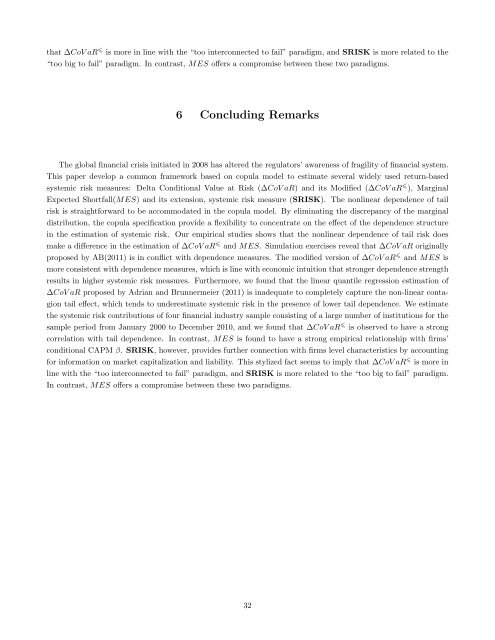Does Tail Dependence Make A Difference In the ... - Boston College
Does Tail Dependence Make A Difference In the ... - Boston College
Does Tail Dependence Make A Difference In the ... - Boston College
Create successful ePaper yourself
Turn your PDF publications into a flip-book with our unique Google optimized e-Paper software.
that ∆CoV aR is more in line with <strong>the</strong> “too interconnected to fail” paradigm, and SRISK is more related to <strong>the</strong><br />
“too big to fail” paradigm. <strong>In</strong> contrast, MES offers a compromise between <strong>the</strong>se two paradigms.<br />
6 Concluding Remarks<br />
The global financial crisis initiated in 2008 has altered <strong>the</strong> regulators’ awareness of fragility of financial system.<br />
This paper develop a common framework based on copula model to estimate several widely used return-based<br />
systemic risk measures: Delta Conditional Value at Risk (∆CoV aR) and its Modified (∆CoV aR ), Marginal<br />
Expected Shortfall(MES) and its extension, systemic risk measure (SRISK). The nonlinear dependence of tail<br />
risk is straightforward to be accommodated in <strong>the</strong> copula model. By eliminating <strong>the</strong> discrepancy of <strong>the</strong> marginal<br />
distribution, <strong>the</strong> copula specification provide a flexibility to concentrate on <strong>the</strong> effect of <strong>the</strong> dependence structure<br />
in <strong>the</strong> estimation of systemic risk. Our empirical studies shows that <strong>the</strong> nonlinear dependence of tail risk does<br />
make a difference in <strong>the</strong> estimation of ∆CoV aR and MES. Simulation exercises reveal that ∆CoV aR originally<br />
proposed by AB(2011) is in conflict with dependence measures. The modified version of ∆CoV aR and MES is<br />
more consistent with dependence measures, which is line with economic intuition that stronger dependence strength<br />
results in higher systemic risk measures. Fur<strong>the</strong>rmore, we found that <strong>the</strong> linear quantile regression estimation of<br />
∆CoV aR proposed by Adrian and Brunnermeier (2011) is inadequate to completely capture <strong>the</strong> non-linear contagion<br />
tail effect, which tends to underestimate systemic risk in <strong>the</strong> presence of lower tail dependence. We estimate<br />
<strong>the</strong> systemic risk contributions of four financial industry sample consisting of a large number of institutions for <strong>the</strong><br />
sample period from January 2000 to December 2010, and we found that ∆CoV aR is observed to have a strong<br />
correlation with tail dependence. <strong>In</strong> contrast, MES is found to have a strong empirical relationship with firms’<br />
conditional CAPM β. SRISK, however, provides fur<strong>the</strong>r connection with firms level characteristics by accounting<br />
for information on market capitalization and liability. This stylized fact seems to imply that ∆CoV aR is more in<br />
line with <strong>the</strong> “too interconnected to fail” paradigm, and SRISK is more related to <strong>the</strong> “too big to fail” paradigm.<br />
<strong>In</strong> contrast, MES offers a compromise between <strong>the</strong>se two paradigms.<br />
32
















